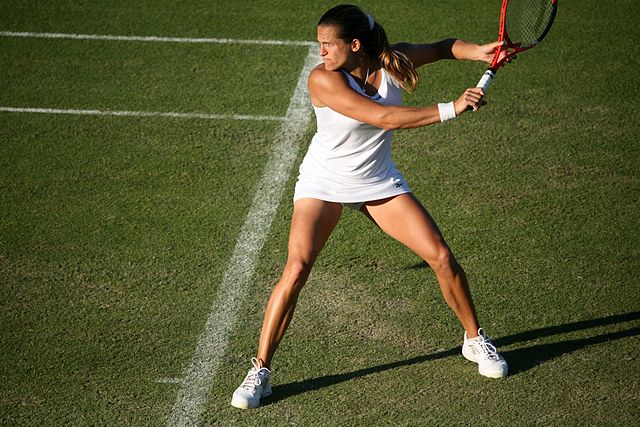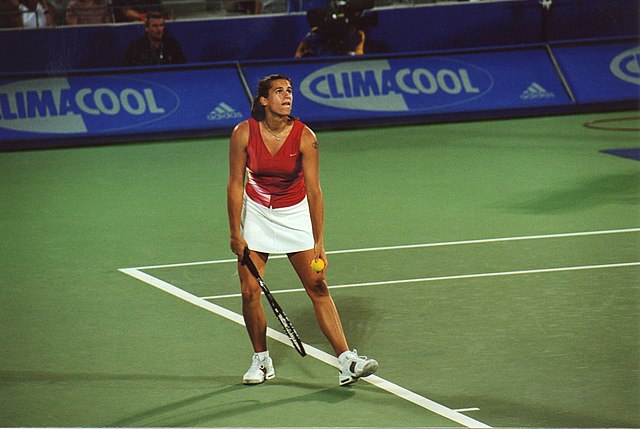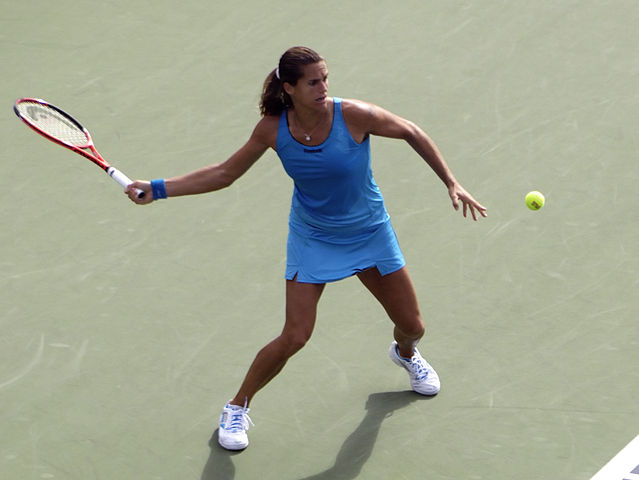
In 2022, I’m counting down the 128 best players of the last century. With luck, we’ll get to #1 in December. Enjoy!
* * *
Amélie Mauresmo [FRA]Born: 5 July 1979
Career: 1995-2009
Plays: Right-handed (one-handed backhand)
Peak rank: 1 (2004)
Peak Elo rating: 2,307 (1st place, 2005)
Major singles titles: 2
Total singles titles: 25
* * *
As the new tournament director at the French Open this year, Amélie Mauresmo found herself the inadvertent center of attention. The event staged one-match night sessions for the first time in its history, and almost every evening of the fortnight, Mauresmo gave that spotlight to men, not women.
She said, “In this era we are in right now–and as a woman, a former woman’s player, I don’t feel bad or unfair saying this–you have more attraction and appeal, in general, for the men’s matches.” Most days, the women’s field didn’t offer a “confrontation or star” that would fit the schedule.
There were also practical concerns. A one-match session could easily turn out to be a dud, especially if a best-of-three contest ended quickly. While plenty of best-of-five men’s matches are boring, too, at least they last a couple of hours. Mauresmo said that the tournament might address the timing issue by adding a doubles match to the session next year. It might work, but broadcasters rarely salivate at the prospect of early-round doubles in prime-time.
The responses to Mauresmo’s comments, of course, were immediate and emotional. Everyone from Iga Swiatek to Billie Jean King chimed in. It’s a matter of respect; balanced programming is key to growing the sport; and there are plenty of great women’s matches, like the Alizé Cornet-Jelena Ostapenko clash that did merit the night session.
All true, as far as it goes. However, few people took issue with Mauresmo’s central argument. For fans and television schedulers, a handful of famous, veteran names rule the sport. With figures like Ashleigh Barty and Serena Williams missing from the women’s side, men such as Novak Djoković and Rafael Nadal were obvious choices for top billing.
BBC commentator Annabel Croft defended the schedule. “There have been periods when the women’s game has been more interesting than the men’s but I have to say the women’s game has had a bit of a dip lately.”
That historical context helps explain why Mauresmo was willing to give center stage to one gender over the other. When the roles were reversed, she was one of the women appearing on the front page of the newspaper in the morning and playing on center court at night. She knows there will be years when women justifiably monopolize the Roland Garros night sessions. This just wasn’t one of them.
* * *
Mauresmo reached her first major final at the 1999 Australian Open, when she was 19 years old. The women’s draw in Melbourne had everything. Martina Hingis was the defending champion, but she hadn’t won much in the twelve months since. The field was full of stars past and future, from Steffi Graf to Monica Seles to Venus Williams.
By comparison, the men’s draw was “the rough equivalent of the jayvee game,” as Harvey Araton put it in the New York Times. Sports Illustrated called the eventual finalists, Thomas Enqvist and Yevgeny Kafelnikov, “duller than oatmeal.”
There was nothing dull about women’s tennis at the turn of the century. At the 1999 Australian, it was the unseeded, 29th-ranked Mauresmo who caused things to get even spicier than usual.

Amélie wasn’t on the radar of most fans, who thought of her as a name for the future if they thought of her at all. She saved match points in the first round, then opened up the draw with a three-set upset win over 8th seed Patty Schnyder in the second. She cruised to the semifinals with three easy wins, including a quarter-final defeat of Mary Pierce.
By the time she faced top seed Lindsay Davenport in the semi-final, Mauresmo was on everyone’s radar, and not because of her first-week victories. Early in the event, she came out as gay to French media. The Aussie tabloids jumped on the story.
The coverage of the 19-year-old’s sexuality ramped up further after she narrowly got past Davenport. She won 103 points to the American’s 102 in a 4-6, 7-5, 7-5 victory. Davenport said more than she meant to in a post-match interview: “A couple of times, I mean, I thought I was playing a guy out there, the girl was hitting it so hard, so strong, and I would look over there and she’s so strong in the shoulders, those shoulders.”
There’s a long history of commentators and opponents talking about women–usually the best of them–playing like men. Often, such remarks were intended as compliments, even if they sound increasingly cringey to a modern ear. Davenport was, to all appearances, just explaining how she was overpowered. A week after Mauresmo came out, though, it sounded like something else.
Davenport was quick to apologize, personally and sincerely. The same was not true of Hingis, who would face Mauresmo in the final. The Swiss Miss said her opponent was “half a man,” and she griped about the Frenchwoman’s public displays of affection. Hingis’s apology was as perfunctory as Davenport’s was genuine.
Alas, this was not a Hollywood movie. The unheralded teen who overcame one obstacle after another, revealing her true self along the way, did not win the tournament. The villain ended up on top. Hingis claimed her third straight Australian Open, 6-2, 6-3.
* * *
Amélie’s Australian adventure prepared her for the media attention she’d receive up to the present day. But the storybook ending was a long time coming.
Two years after her Melbourne final, she was barely hanging on to a spot in the WTA top 20. It wasn’t until the US Open in 2001 that she reached another grand slam quarter-final. She lost that match to Jennifer Capriati, and she lost her next five encounters with top-tenners as well.
In fairness, it was not an easy time to climb the women’s tennis ladder. Consider some of the top women born between 1975 and 1983:
Birth Player 1975 Mary Pierce 1976 Jennifer Capriati 1976 Lindsay Davenport 1979 Amélie Mauresmo 1980 Martina Hingis 1980 Venus Williams 1981 Elena Dementieva 1982 Serena Williams 1982 Justine Henin 1983 Kim Clijsters
If great players were evenly distributed throughout the last century, my Tennis 128 list would contain five women from that time span. Instead, there are ten, some of them very close to the top of the all-time rankings. (Spoiler alert: Both Williams sisters are on the list.)
Eventually, Mauresmo would hold her own against most of her peers. She won only 2 of 12 against Serena Williams, but she managed 3 of 8 against Venus Williams. She split 14 meetings with Hingis, and almost broke even against Justine Henin and Kim Clijsters. She won her career series against Capriati, Pierce, and Elena Dementieva.

Those wins helped her climb the rankings, but in the early 2000s, Amélie could only watch while the Williams sisters dominated all the tournaments that mattered. In 2002, she lost a quarter-final in Australia to Capriati, a semi at Wimbledon to Serena, and a nail-biter of a US Open semi-final to Venus. While she cracked the WTA top five for the first time, a major title still seemed a long way off.
* * *
Journalists found it easy to construct a narrative around Mauresmo’s struggles. She never regretted coming out, but the added attention–much of it negative–both distracted her and added to the pressure she faced. Plus, she gained a reputation as a choker, a talented player who didn’t have what it took to win the big matches.
Like many players whose mental strength is questioned, Amélie has accepted the judgment, at least as an explanation for part of her career. She’ll talk about how she was afraid to win, until she finally realized–around 2004–that it ought to have been her name on the trophy instead.
Maybe so. Certainly she improved, and her results took a leap forward that season. She won 63 of 75 matches, claiming four titles and reaching number one on the WTA computer–albeit briefly–ahead of the likes of Davenport, Henin, and Serena.
On the other hand, there are plenty of other reasons why Mauresmo took longer than her peers to put things together. She told the Guardian in 2006 that she wasn’t “a tennis machine.” Despite winning two junior slams, she was never a can’t-miss prospect. According to French journalist Alain Deflassieux, she wasn’t even the best youngster among the strong crop of Frenchwomen born in 1979.
Mauresmo was a fascinating player to watch, even apart from the inconsistency that drove the “choker” narrative. She boasted a flashy one-handed backhand somewhere between those of Henin and Richard Gasquet, and she was never afraid to move forward. She rarely went out of her way to play grass-court events, but her game was suited to the surface. In the 2006 Wimbledon final, she serve-and-volleyed 33 times.
The variety was a blessing and a curse. Amélie told the Guardian:
It didn’t help me for a long time. When you have a choice you have to make the right one. When you don’t have a choice you do what you know how to do best and that’s about it. When you have a repertoire–for this ball a chip down the line? Or a top spin short across the court?–there’s a chance that you’ll make the wrong decision.
A chosen few, like Martina Hingis, seem to come out of the womb knowing how to make those choices. For the rest of us, including some of the greatest players in the game’s history, it takes time.
* * *
After her triumphant 2004 campaign, it seemed that Mauresmo might finally win a major. Instead, the 2005 season played out just like the one before. She won just four games against Serena in Australia. She crashed out early to a young Ana Ivanović in Paris. Davenport beat her in a marathon, narrative-reinforcing three-setter at Wimbledon. Then Amélie limped out of the US Open after a 6-4, 6-1 defeat at the hands of Pierce.
Pierce beat her again to kick off the round robin stage of the year-end championships in Los Angeles, but then the tides turned. Mauresmo beat Clijsters and Dementieva in straight sets to advance to the knockout stage, then defeated Maria Sharapova in the semi-final and Pierce in a rematch for the title. While it wasn’t a major, it was the next best thing.
And it was a major confidence boost. Mauresmo would end up winning eleven matches in a row against top-ten opponents, including finals against Henin, Pierce, and Clijsters to kick off 2006.
The Henin match was an unsatisfying victory by retirement, but Amélie could only complain so much: It was her first grand slam title. Her path to the 2006 Australian Open championship was bizarre: She beat Michaëlla Krajicek, Clijsters, and Henin by retirement, and Henin’s ailment was a stomach bug she probably could’ve played through.
Retirements or not, the wins counted. Mauresmo would reclaim the number one position in the rankings in March.
She would justify her position–and her asterisked win in Melbourne–with another big performance at Wimbledon. This time, all seven matches finished when Amélie converted match point. She cast aside any remaining doubts about her mental fortitude, bouncing back from lost second sets against Anastasia Myskina in the quarters and Sharapova in the semis. Then she recovered after losing the first set to Henin in the final. Faced with the pressure of serving for the most storied trophy in tennis, she opened her final game with two aces, executed a textbook serve-and-volley point at 30-all, and coaxed an unforced error from the Belgian to finish the job.
* * *
Mauresmo’s fall from the top was even quicker than her belated rise. She reached the final at the 2006 year-end championships, where she lost to Henin. She beat Clijsters for the 2007 Antwerp title, but the tournament represented 4 of only 27 wins that season. She didn’t reach the quarter-finals in either of her grand slam title defenses.
After two more indifferent seasons, she retired, a few months after her 30th birthday.
Her post-retirement career, however, has been almost as impressive as her decade-plus on court. She helped Marion Bartoli to the 2013 Wimbledon title, and she coached Andy Murray from 2014 to 2016, helping him to his first tournament wins on clay. She was in Lucas Pouille’s box for the young Frenchman’s surprise run to the 2018 Australian Open semi-final.
Now, she runs the French Open, one of the four biggest events on the tennis calendar. Time will tell whether she excels at the helm of a major championship, and whether she even finds it interesting enough to stick around for long. In a good year, the tournament director will spend more of her time behind the scenes. But when the pressure and media attention does arrive, it won’t faze her at all.